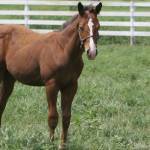Osteochondrosis in Young Horses: Genetics or Nutrition?

For decades, researchers have tried to pinpoint the cause of osteochondrosis in horses. Why the concern? Osteochondrosis remains an important cause of joint swelling, lameness, poor performance, wastage, and economical losses throughout the equine industry, including young Thoroughbred populations.
“Osteochondrosis occurs when the articular cartilage that lines the ends of long bones fails to mature into sound bone early in a horse’s life, a process referred to as endochondral ossification,” explained Kathleen Crandell, Ph.D., a Kentucky Equine Research (KER) nutritionist.
Despite the volumes of research on this important topic, conflicting data continue to be published, leaving researchers, veterinarians, and horse breeders uncertain as to the most important cause of osteochondrosis. As succinctly described in a recent article*, what is known is that osteochondrosis is multifactorial, involving nutrition, conformation, body size, trauma, and genetics.
To help clarify the osteochondrosis situation, one group of Australian veterinarians recently reviewed radiographs of 1,962 Thoroughbred yearlings, identified the presence and location of osteochondrosis lesions, and measured the “heritability” of osteochondrosis by reviewing each affected yearling’s pedigree. Key findings of the study were:
- Overall, osteochondrosis was identified in 23% of included horses;
- Osteochondrosis was found in 10% of stifle joints, 6% of hock joints, and 8% of fetlock joints; and
- Heritability estimates for osteochondrosis were low (ranging from 0 to 0.2 on a scale of 0 to 1), suggesting that only a proportion of osteochondrosis cases in Thoroughbreds are heritable.
While genetics may still play a role in osteochondrosis, these data suggest that nongenetic factors have a substantial influence on most osteochondrosis lesions. In fact, one of the most important determinants of osteochondrosis in this study was dam environment.
According to Russell and colleagues, “…breeding and farm management practices (e.g., feeding) or other factors such as parity or age of mares may be related to likelihood of osteochondrosis and could potentially be used to alter the prevalence of osteochondrosis lesions in the Thoroughbred.”
“These data support other studies suggesting that mare nutrition plays an important role in foal health,” relayed Crandell.
Ensuring mares maintain a healthy body condition score before, during, and after pregnancy and lactation; avoiding micronutrient imbalances (including deficiencies and excess), and avoiding foal overnutrition all help minimize the occurrence of osteochondrosis.
Consult with an equine nutritionist today to maximize your mare’s diet.
*Russell, J., O. Matika, T. Russell, and R.J.M. Reardon. 2017. Heritability and prevalence of selected osteochondrosis lesions in yearling Thoroughbred horses. Equine Veterinary Journal 49:282-287.








